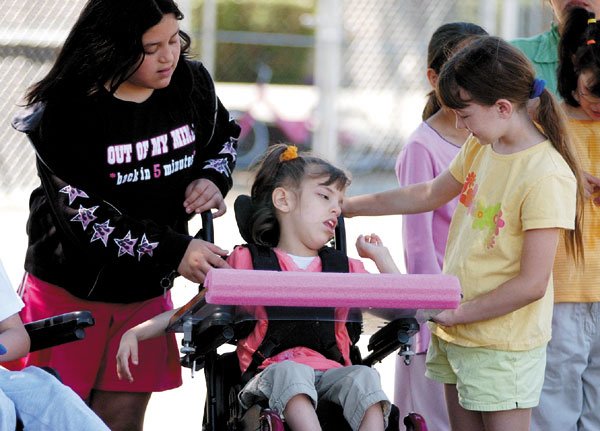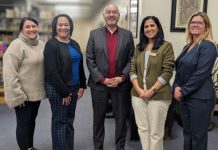Eliot School volunteers open campus
– and their hearts – to Gateway School students
By Deliah Deleon Special to the Dispatch
Gilroy – Everyone knows the feeling of being the “new kid” on campus. But for 12 Gateway students who attended class at Eliot Elementary School recently, they were made to feel right at home.
The students were housed on Eliot’s campus from mid-April through the end of the term because Gateway School underwent renovations. The school is exclusively for mentally challenged and disabled children.
The experience appears to have been a positive one for students at both schools.
“It’s so heart warming,” said Angela Jimenez, whose 14-year-old disabled son was greeted off the bus in the mornings by Eliot students wanting to escort their new friend on campus.
“One of the reasons I didn’t want him to go to Gateway was because it was all-inclusive with disabled kids,” she said. “It’s so sad that once they get older they’re even more separated.”
Jimenez was particularly impressed with one first grade student who wrote something positive about each disabled child.
“I think (the Eliot students) learned so much too,” she said. “The kids learn not be fearful of disabled people and not to look away.”
About 180 Eliot students volunteered in the Gateway classroom.
Heather Bass, the Gateway teacher, gave special recognition to the students who attended her classroom. The “20 Club” was for students who have attended her classroom 20 times or more; 13 students made the list.
“There are so many volunteers that we had to spread them out and only allow them to attend our classroom once a week,” said Bass.
The Eliot volunteers read to Gateway students, played with them and took them for walks outside. The students participated in activities such as “circle time,” an hour-long session where they learn general academics, and even sign language.
“We’ve never been on a campus before, and now we realize it makes sense,” said Bass. “I almost feel like keeping these children out of regular schools is unfair, especially since they are wanted here. These families have been struggling to get their children accepted and appreciated, I need to advocate for these children. Now they no longer feel like they don’t belong or aren’t appreciated or accepted.”
Within a month of spending time with the disabled students, Eliot students learned about individual disabilities, how to work with their emotions, and the activities they enjoy.
“My teacher told us that they really needed help, and that they needed volunteers, so we volunteered,” said Eliot fourth grader Elogia Benitez.
Carol Mendoza, a first-grader at Eliot Elementary School, was one of the top volunteers. She drew pictures for the students, made birthday cards, brought in treats and even wrote a letter saying that she likes working with the Gateway children.
“She is really into reading to them and helping them learn; she really motivates them,” Bass said. “The children get happy and excited when someone is around to play with them.”
Bass held an awards ceremony on June 9 for both Eliot and Gateway students where she handed out more than 100 awards to the Eliot students as a thank you volunteering.
” I just want to thank the principal of Eliot, Diane Elia,” Bass said. “She made the offer for us to have this beautiful classroom.”
The idea of integrating disabled students is not new, but part of a growing movement in Special Education, said Barry Goldman-Hall, clinical director at Community Solutions.
He believes the experience is an important part of their education.
“I think kids are innately accepting,” he explained. “Once they are of school age they can either learn to be afraid and discriminatory or open and accepting. Anytime we can kind of normalize the experience of disabled kids … that’s kind of a win-win.”
Disabled children are able to interact with other children without being stigmatized. And the Eliot students can serve as role models, Goldman-Hall said.
“I feel like we’re sort of early on teaching them how to be altruistic,” he said. “We’re kind of building empathy and compassion. Students gain sensitivity. They learn not to be afraid because there is a lot of fear around disabilities. These kids also have strengths.”
He believes that separating children unknowingly teaches them to acknowledge the differences between them instead of the similarities they share.
“It’s the whole phenomenon of the little yellow school bus and who was on it,” Goldman-Hall explained. “They were different. They went to school differently than us. I want to think that we’re better than that.”
Staff Writer Kristen Munson contributed to this story.














